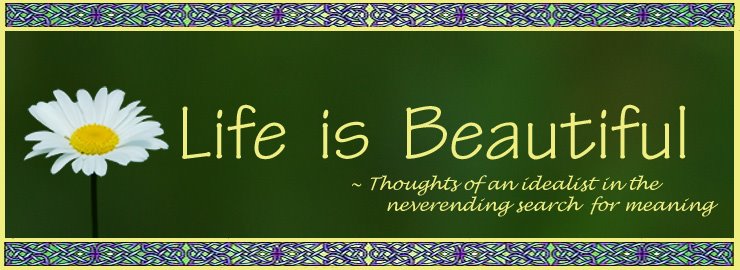
~photo courtesy of Indiana University
Hi everyone! I'm sorry I've been so scarce in the blogosphere lately. In my absence, I've been blown away with the ideas and insights of Eckhart Tolle and Dr. Jill Bolte-Taylor (thanks, Janey!!!) Both have written books and can be found in various interviews and videos on the web-- so, I've been spending hours soaking it all up.
:)
As I discussed in my last post, Tolle defines the "ego" as the part of us that thinks with words, the voice in our head. He believes that this voice is not our true self. Rather, we are the presence that hears the voice. And, if we consciously turn off the ego's voice and simply be present and aware of our senses, we will find a simple, open state of peace and joy.
One problem that I have is that Tolle's descriptions can come off as having a spiritual, even religious, feeling. He describes this ego-less state as energy which connects us all. Is it a higher plane of existence? Is it a brush with the divine? No. He's not really saying that at all. But as a probable Idealist (one of Keirsey's temperament types), Tolle has some difficulty nailing down his words in black and white. In a more scientific straight-forwardness. That's where Dr. Jill Bolte-Taylor has made a huge contribution.
Dr. Bolte-Taylor is a Harvard-trained neuroanatomist who had a stroke at age 37. And, she remained awake and conscious the entire time and was able to perceive the changes in her brain as they happened! How cool is that?! Her left-sided hemorrhage effectively shut down her entire left hemisphere (language, rational and linear thinking, math skills). So she was living with only the functions of her right brain (intuition, contextual understanding, perception of intonation, spatial skills). She describes the experience in her book My Stroke of Insight.
Check out this incredible video of a talk she gave several years ago:
What I find fascinating, is that when her left hemisphere stopped working, she experienced the awareness of being that Tolle describes. She says that she lost her ego. That her thinking was silenced because the section of the brain that processes language completely shut down.

~excerpt from Oprah's Soul Series radio show (archived at Oprah.com)
So is the ego actually our left hemisphere? It appears so. Our ability to use language seems to be the key to what ego is.
We think in words because we evolved language. And certainly, shared language is a huge advantage for survival. But, this thinking mind is also a bit of a curse.
To think requires words, which are just man-made labels for ideas and concepts. As Tolle teaches, words are just guideposts that point us to the ideas, they are not truth. And this is the curse. Just think of all the thoughts that we have. Aren't we defining our experiences (or limiting them) with thought? And so often, thoughts tend to either amplify emotion or block emotion. This is why some people preach positive thinking as a way to feel happier. But thoughts are not emotions.
Emotion is a physical function. It happens deep in the brain in the amygdala. It is a specific physiologic response that protects us and enhances our survival by, for example, preparing us to fight or flee when fear is triggered, or by creating a desire to attach to a caregiver or loved one when feelings of safety (happiness, joy, etc.) are triggered. Pure emotion (the physiological response) is fleeting. The brain function only lasts from a few minutes to about 20 minutes maximum (for fear and anger). But, thanks to our thinking mind, we continue to experience what we believe is fear or anger for hours, days, even years! In actuality, we trick our brain into triggering the emotional response in the absence of a real life event. By having thoughts. By having an ego that tells us stories.
It's the price we pay for having language.
So, can we stop creating these thought-induced emotional experiences? Yes! As Dr. Bolte-Taylor knows, we can turn off our left-hemisphere. As Tolle teaches, we can silence the ego. And the result is peace, joy, an undefinable (because we can't apply words to it) sense of connection with life. It is pure living, without the curse of false, thought-induced negative emotions.
Dr. Bolte-Taylor calls it Nirvana.
I call it life. And, of course...
Life is Beautiful...
:)



































